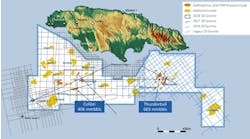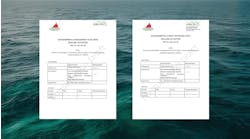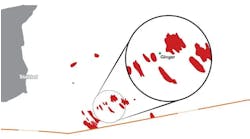Nick Terdre
Contributing Editor
Fire and seawater pumping systems for the UK's Britannia Field development are being integrated into one design with the aim of enhancing reliability and cutting topsides weight.
Traditionally, topsides are fitted with separate systems due to a legal requirement to have dedicated fire pumps for firefighting. This leads to duplication, with similar pumps, caissons, drivers and control systems supplied for the separate duties.
Britannia's fire pump arrangement comprises three identical dual-duty electro-submersible lift pumps, each rated for 100% of the maximum fire-water demand of 50% of the process and utilities cooling requirement. Two of these pumps will always be run under normal operation.
Two diesel engine-driven generators will drive two of the pumps, with the topsides' main turbo-generators driving the third lift pump. This will provide two fire pump units working at 100% with an added, high availability 100% fire-water source. Each of these units are standalone, containing a fire pump, driver, controller and accessories. They are segregated operationally and physically from the other unit and the added fire-water source.
Fire protection Workshop
A workshop will be held in Aberdeen this summer to outline findings to date of the International Jet Fire Test working group. This body was convened in 1992 by the Health and Safety Executive and the Norwegian Petroleum Directorate following a study by Shell and Norwegian institute Sintef that large-scale jet fire conditions could be produced on a much smaller scale.
Late in 1993 HSE published a report on an interim jet fire test for determining the effectiveness of passive fire protection materials. Validation of this new procedure was urged to prove uniformity of results between test houses and to compare its results with those of large-scale tests.
Working group member British Gas subsequently arranged for identical test boxes to be produced and instrumented, three coated with one intumescent material and three with another material. These were then put through jet fire tests at Sintef, Health and Safety Laboratories and Southwest Research Institute (SRI). Results proved that the new test was a producible procedure.
Now the procedure is being extended to other products. British Gas will test two I-beams coated with different intumescent materials, and a large and small diameter tubular, both in a 3kg/s jet fire. SRI will test a small diameter tubular in a 0.3kg/s jet flame. Both sets of results will be presented at Aberdeen.
For more information telephone Carol Carney, HSE Offshore Safety Division on +44 151 9514871.
ABB supervises Judy control
Phillips UK's Judy platform, installed last year, features a A5 million integrated control, monitoring and safety system - one of the first on a UK production installation, according to supplier ABB Industrial Systems.
The package comprises a distributed control system based on the ABB Master Process Control system. Main equipment includes MasterPiece controllers with MasterView operator display stations; SuperView management reporting system; and MasterSafeguard emergency shutdown and fire and gas detection systems.
The latter supports extended self-testing and fault-handling routines of the processing units (watch-dogs, execution supervision) and process interface connections (status and unit errors, individual status and output signal readback).
Equipment is distributed at Phillips' Ekofisk platform and onshore at Aberdeen, as well as on the Judy platform. The control system, designed with main contractor Kvaerner H&G Offshore, features a novel three-way data routing system to ensure that critical gas production data is accurately transmitted to the CATS gas reception terminal on Teesside.
Brown & Root has awarded the contract for BP's Schiehallion FPSO control systems to Silvertech of Horsham, UK. These comprise control and process shutdown, ESD, fire and gas, and vessel machinery control systems - all to be fully integrated with distributed processing, I/O sub-systems and operator interfaces, based around Silvertech's Unified Control System concept.
Copyright 1996 Offshore. All Rights Reserved.


